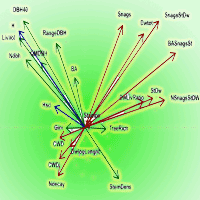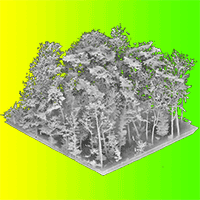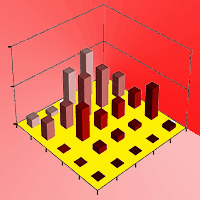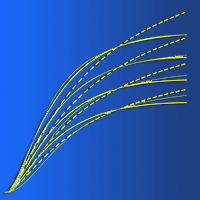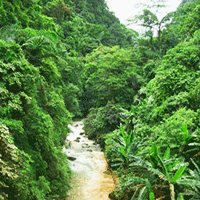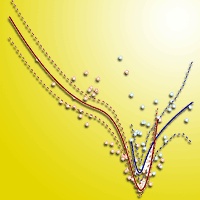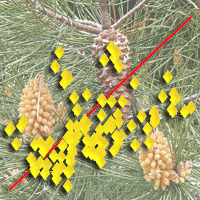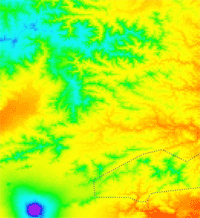Forest management with a focus on high structural heterogeneity is a major goal in modern forestry to increase multifunctionality. The assessment and quantification of forest structures has, therefore, gained much attention in recent years. However, there is no standardized approach to surveying forest heterogeneity; instead, a variety of structural indices, which have been developed over past decades, are used. This makes it difficult to interpret the results of different studies and to base management decisions on such data. In this study, we compared six structural indices that differ in terms of their complexity and the method of data acquisition. These included the Gini coefficient of the diameter at breast height and of tree height, the Shannon index of tree species diversity, two complex indices of structural heterogeneity, one based on conventional inventory data and one on terrestrial laser scanning (TLS) data, and a simple-holistic TLS-based stand structural complexity index. For the comparison of these six indices, we used data from 84 plots in 12 different forest stand types in two study areas in Germany. The stand types consisted of different dominant tree species and included different age classes. The degree of correlations among the different indices was highly variable. In addition, we did not find a clear age-dependency of the indices. We conclude that the choice of a specific index plays an important role in the evaluation and interpretation of forest structural heterogeneity. Because TLS data offer multiple benefits in terms of precision, reproducibility and comprehensiveness, we recommend to use TLS-based indices of structural heterogeneity.
Keywords
, , , ,
Citation
Reich KF, Kunz M, Bitter AW, Von Oheimb G (2022). Do different indices of forest structural heterogeneity yield consistent results?. iForest 15: 424-432. - doi: 10.3832/ifor4096-015
Academic Editor
Claudia Cocozza
Paper history
Received: Mar 07, 2022
Accepted: Aug 09, 2022
First online: Oct 20, 2022
Publication Date: Oct 31, 2022
Publication Time: 2.40 months
© SISEF - The Italian Society of Silviculture and Forest Ecology 2022
Open Access
This article is distributed under the terms of the Creative Commons Attribution-Non Commercial 4.0 International (https://creativecommons.org/licenses/by-nc/4.0/), which permits unrestricted use, distribution, and reproduction in any medium, provided you give appropriate credit to the original author(s) and the source, provide a link to the Creative Commons license, and indicate if changes were made.

Breakdown by View Type
(Waiting for server response...)
Article Usage
Total Article Views: 30954
(from publication date up to now)
Breakdown by View Type
HTML Page Views: 25415
Abstract Page Views: 3011
PDF Downloads: 2093
Citation/Reference Downloads: 8
XML Downloads: 427
Web Metrics
Days since publication: 1151
Overall contacts: 30954
Avg. contacts per week: 188.25
Article Citations
Article citations are based on data periodically collected from the Clarivate Web of Science web site
(last update: Mar 2025)
Total number of cites (since 2022): 6
Average cites per year: 1.50
Publication Metrics
by Dimensions ©
Articles citing this article
List of the papers citing this article based on CrossRef Cited-by.
(1)
Akerblom M, Raumonen P, Mäkipää R, Kaasalainen M (2017)Automatic tree species recognition with quantitative structure models. Remote Sensing of Environment 191: 1-12.
CrossRef |
Gscholar
(2)
August PV (1983)The role of habitat complexity and heterogeneity in structuring tropical mammal communities. Ecology 64: 1495-1507.
CrossRef |
Gscholar
(3)
Bauhus J, Püttmann KJ, Kühne C (2013)Close-to-nature forest management in Europe: does it support complexity and adaptability of forest ecosystems? In: “Managing Forests as Complex Adaptive Systems: Building Resilience to the Challenge of Global Change”. The Earthscan Forest Library, Routledge, London, pp. 368.
CrossRef |
Gscholar
(4)
Beckschäfer P, Mundhenk P, Kleinn C, Ji Y, Yu DW, Harrison RD (2013)Enhanced structural complexity index: an improved index for describing forest structural complexity. Open Journal of Forestry 3: 23-29.
CrossRef |
Gscholar
(5)
Bienert A, Hess C, Maas H, Von Oheimb G (2014)A voxel-based technique to estimate the volume of trees from terrestrial laser scanner data. The International Archives of Photogrammetry, Remote Sensing and Spatial Information Sciences 40: 101.
CrossRef |
Gscholar
(6)
Brang P, Spathelf P, Larsen JB, Bauhus J, Boncina A, Chauvin C, Drossler L, Garcia-Guemes C, Heiri C, Kerr G, Lexer MJ, Mason B, Mohren F, Muhlethaler U, Nocentini S, Svoboda M (2014)Suitability of close-to-nature silviculture for adapting temperate European forests to climate change. Forestry 87: 492-503.
CrossRef |
Gscholar
(7)
Buongiorno J, Dahir S, Lu H-C, Lin C-R (1994)Tree size diversity and economic returns in uneven-aged forest stands. Forest Science 40: 83-103.
Online |
Gscholar
(8)
Calders K, Adams J, Armston J, Bartholomeus H, Bauwens S, Bentley LP, Chave J, Danson FM, Demol M, Disney M, Gaulton R, Krishna Moorthy SM, Levick SR, Saarinen N, Schaaf C, Stovall A, Terryn L, Wilkes P, Verbeeck H (2020)Terrestrial laser scanning in forest ecology: expanding the horizon. Remote Sensing of Environment 251: 112102.
CrossRef |
Gscholar
(9)
Del Río M, Pretzsch H, Alberdi I, Bielak K, Bravo F, Brunner A, Condés S, Ducey MJ, Fonseca T, Von Lüpke N, Pach M, Peric S, Perot T, Souidi Z, Spathelf P, Sterba H, Tijardovic M, Tomé M, Vallet P, Bravo-Oviedo A (2016)Characterization of the structure, dynamics, and productivity of mixed-species stands: review and perspectives. European Journal of Forest Research 135: 23-49.
CrossRef |
Gscholar
(10)
DWD (2020)Vieljährige Stationsmittelwerte für die Klimareferenzperiode 1981-2010, für aktuellen Standort und Bezugsstandort [Multi-year station averages for the 1981-2010 climate reference period, for current site and reference site]. DWD Climate Data Center, Deutscher Wetterdienst, Offenbach, Germany, web site. [in German]
Online |
Gscholar
(11)
Ehbrecht M, Schall P, Juchheim J, Ammer C, Seidel D (2016)Effective number of layers: a new measure for quantifying three-dimensional stand structure based on sampling with terrestrial LiDAR. Forest Ecology and Management 380: 212-223.
CrossRef |
Gscholar
(12)
Ehbrecht M, Schall P, Ammer C, Seidel D (2017)Quantifying stand structural complexity and its relationship with forest management, tree species diversity and microclimate. Agricultural and Forest Meteorology 242: 1-9.
CrossRef |
Gscholar
(13)
Felipe-Lucia MR, Soliveres S, Penone C, Manning P, Van Der Plas F, Boch S, Prati D, Ammer C, Schall P, Gossner MM, Bauhus J, Buscot F, Blaser S, Blüthgen N, De Frutos A, Ehbrecht M, Frank K, Goldmann K, Hänsel F, Jung K, Kahl T, Nauss T, Oelmann Y, Pena R, Polle A, Renner S, Schloter M, Schöning I, Schrumpf M, Schulze E-D, Solly E, Sorkau E, Stempfhuber B, Tschapka M, Weisser WW, Wubet T, Fischer M, Allan E (2018)Multiple forest attributes underpin the supply of multiple ecosystem services. Nature Communications 9: 4839.
CrossRef |
Gscholar
(14)
Georgi L, Kunz M, Fichtner A, Reich KF, Bienert A, Maas H-G, Von Oheimb G (2021)Effects of local neighbourhood diversity on crown structure and productivity of individual trees in mature mixed-species forests. Forest Ecosystems 8: 26.
CrossRef |
Gscholar
(15)
Gini C (1912)Variabilità e mutabilità: contributo allo studio delle distribuzioni e delle relazioni statistiche [Variability and mutability: contribution to the study of distributions and statistical relationships]. Tipografia P. Cuppini, Bologna, Italy, pp. 168. [in Italian]
Gscholar
(16)
Gustafsson L, Baker SC, Bauhus J, Beese WJ, Brodie A, Kouki J, Lindenmayer DB, Lõhmus A, Pastur GM, Messier C, Neyland M, Palik B, Sverdrup-Thygeson A, Volney WJA, Wayne A, Franklin JF (2012)Retention forestry to maintain multifunctional forests: a world perspective. BioScience 62: 633-645.
CrossRef |
Gscholar
(17)
Hackenberg J, Wassenberg M, Spiecker H, Sun D (2015)Non destructive method for biomass prediction combining TLS derived tree volume and wood density. Forests 6: 1274-1300.
CrossRef |
Gscholar
(18)
Hildebrand M, Perles-Garcia MD, Kunz M, Härdtle W, Von Oheimb G, Fichtner A (2021)Tree-tree interactions and crown complementarity: the role of functional diversity and branch traits for canopy packing. Basic and Applied Ecology 50: 217-227.
CrossRef |
Gscholar
(19)
Kassambara A, Mundt F (2020)factoextra: extract and visualize the results of multivariate data analyses. R package, web site.
Online |
Gscholar
(20)
Keren S, Svoboda M, Janda P, Nagel TA (2019)Relationships between structural indices and conventional stand attributes in an old-growth forest in Southeast Europe. Forests 11: 4.
CrossRef |
Gscholar
(21)
Kunz M, Hess C, Raumonen P, Bienert A, Hackenberg J, Maas H, Härdtle W, Fichtner A, Von Oheimb G (2017)Comparison of wood volume estimates of young trees from terrestrial laser scan data. iForest - Biogeosciences and Forestry 10: 451-458.
CrossRef |
Gscholar
(22)
Lang AC, Härdtle W, Bruelheide H, Geiler C, Nadrowski K, Schuldt A, Yu M, Von Oheimb G (2010)Tree morphology responds to neighbourhood competition and slope in species-rich forests of subtropical China. Forest Ecology and Management 260: 1708-1715.
CrossRef |
Gscholar
(23)
Lecigne B (2020)VoxR: trees geometry and morphology from unstructured TLS data. R package, web-site.
Online |
Gscholar
(24)
Levin SA (2013)Encyclopedia of biodiversity (2nd edn). Elsevier, Amsterdam, Netherlands and Heidelberg, Germany, pp. 5504.
Gscholar
(25)
Lexerod NL, Eid T (2006)An evaluation of different diameter diversity indices based on criteria related to forest management planning. Forest Ecology and Management 222: 17-28.
CrossRef |
Gscholar
(26)
Liang J, Buongiorno J, Monserud RA, Kruger EL, Zhou M (2007)Effects of diversity of tree species and size on forest basal area growth, recruitment, and mortality. Forest Ecology and Management 243: 116-127.
CrossRef |
Gscholar
(27)
Liang X, Kankare V, Hyyppä J, Wang Y, Kukko A, Haggrén H, Yu X, Kaartinen H, Jaakkola A, Guan F, Holopainen M, Vastaranta M (2016)Terrestrial laser scanning in forest inventories. ISPRS Journal of Photogrammetry and Remote Sensing 115: 63-77.
CrossRef |
Gscholar
(28)
Lin LIK (1989)A concordance correlation coefficient to evaluate reproducibility. Biometrics 45: 255.
CrossRef |
Gscholar
(29)
McElhinny C, Gibbons P, Brack C (2006)An objective and quantitative methodology for constructing an index of stand structural complexity. Forest Ecology and Management 235: 54-71.
CrossRef |
Gscholar
(30)
Park J, Kim HS, Jo HK, Jung IB (2019)The influence of tree structural and species diversity on temperate forest productivity and stability in Korea. Forests 10: 1113.
CrossRef |
Gscholar
(31)
Pebesma E, Bivand R, Rowlingson B, Gomez-Rubio V, Hijmans R, Sumner M, MacQueen D, Lemon J, Lindgren F, O’Brien J, O’Rourke J (2019)sp: classes and methods for spatial data. R package, web site.
Online |
Gscholar
(32)
Perles-Garcia MD, Kunz M, Fichtner A, Härdtle W, Oheimb G (2021)Tree species richness promotes an early increase of stand structural complexity in young subtropical plantations. Journal of Applied Ecology 58: 2305-2314.
CrossRef |
Gscholar
(33)
Pfennigbauer M, Ullrich A (2010)Improving quality of laser scanning data acquisition through calibrated amplitude and pulse deviation measurement. In: Proceedings of the Conference “SPIE 7684, Laser Radar Technology and Applications XV” (MD Turner, GW Kamerman eds). Orlando (Florida) 29 April 2010, 76841F.
CrossRef |
Gscholar
(34)
Pielou EC (1966)The measurement of diversity in different types of biological collections. Journal of Theoretical Biology 13: 131-144.
CrossRef |
Gscholar
(35)
Pretzsch H (2009)Forest dynamics, growth, and yield. Springer, Berlin, Germany, pp. 664.
CrossRef |
Gscholar
(36)
Pretzsch H (2014)Canopy space filling and tree crown morphology in mixed-species stands compared with monocultures. Forest Ecology and Management 327: 251-264.
CrossRef |
Gscholar
(37)
Prokofieva I (2016)Payments for ecosystem services: the case of forests. Current Forestry Reports 2: 130-142.
CrossRef |
Gscholar
(38)
Puettmann KJ, Coates KD, Messier CC (2009)A critique of silviculture: managing for complexity. Island Press, Washington, DC, USA, pp. 189.
Gscholar
(39)
R Core Team (2018)R: a language and environment for statistical computing. R Foundation for Statistical Computing, Vienna, Austria.
Online |
Gscholar
(40)
Raumonen P, Kaasalainen M, Akerblom M, Kaasalainen S, Kaartinen H, Vastaranta M, Holopainen M, Disney M, Lewis P (2013)Fast automatic precision tree models from terrestrial laser scanner data. Remote Sensing 5: 491-520.
CrossRef |
Gscholar
(41)
Reich KF, Kunz M, Von Oheimb G (2021)A new index of forest structural heterogeneity using tree architectural attributes measured by terrestrial laser scanning. Ecological Indicators 133: 108412.
CrossRef |
Gscholar
(42)
Sabatini F, Burrascano S, Lombardi F, Chirici G, Blasi C (2015)An index of structural complexity for Apennine beech forests. iForest - Biogeosciences and Forestry 8: 314-323.
CrossRef |
Gscholar
(43)
San-Miguel-Ayanz J, Barredo J, Viszlai I (2016)Payments for forest ecosystem service: SWOT analysis and possibilities for implementation. Technical Report no. EUR 28128 EN, Joint Research Centre, European Commission, Publications Office, Ispra, Italy.
CrossRef |
Gscholar
(44)
Savicky P (2014)Spearman’s rank correlation test. R package version 0.3-0, website.
Online |
Gscholar
(45)
Schall P, Gossner MM, Heinrichs S, Fischer M, Boch S, Prati D, Jung K, Baumgartner V, Blaser S, Böhm S, Buscot F, Daniel R, Goldmann K, Kaiser K, Kahl T, Lange M, Müller J, Overmann J, Renner SC, Schulze E-D, Sikorski J, Tschapka M, Türke M, Weisser WW, Wemheuer B, Wubet T, Ammer C (2018a)The impact of even-aged and uneven-aged forest management on regional biodiversity of multiple taxa in European beech forests. Journal of Applied Ecology 55: 267-278.
CrossRef |
Gscholar
(46)
Schall P, Schulze E-D, Fischer M, Ayasse M, Ammer C (2018b)Relations between forest management, stand structure and productivity across different types of Central European forests. Basic and Applied Ecology 32: 39-52.
CrossRef |
Gscholar
(47)
Scherzinger W (1996)Naturschutz im Wald: Qualitätsziele einer dynamischen Waldentwicklung [Nature conservation in forests: quality objectives of dynamic forest development]. Ulmer, Stuttgart, Germany, pp. 447. [in German]
Gscholar
(48)
Schuldt A, Ebeling A, Kunz M, Staab M, Guimarães-Steinicke C, Bachmann D, Buchmann N, Durka W, Fichtner A, Fornoff F, Härdtle W, Hertzog LR, Klein A-M, Roscher C, Schaller J, Von Oheimb G, Weigelt A, Weisser W, Wirth C, Zhang J, Bruelheide H, Eisenhauer N (2019)Multiple plant diversity components drive consumer communities across ecosystems. Nature Communications 10: 1460.
CrossRef |
Gscholar
(49)
Segura A, Castaño-Santamaría J, Laiolo P, Obeso JR (2014)Divergent responses of flagship, keystone and resource-limited bio-indicators to forest structure. Ecological Research 29: 925-936.
CrossRef |
Gscholar
(50)
Shannon CE (1948)A mathematical theory of communication. Bell System Technical Journal 27: 379-423.
CrossRef |
Gscholar
(51)
Signorell A, Aho K, Alfons A, Anderegg N, Aragon T, Arachchige C, Arppe A, Baddeley A, Barton K, Bolker B, Borchers HW (2021)DescTools: tools for descriptive statistics. R package, web site.
Online |
Gscholar
(52)
Stiers M, Willim K, Seidel D, Ehbrecht M, Kabal M, Ammer C, Annighöfer P (2018)A quantitative comparison of the structural complexity of managed, lately unmanaged and primary European beech (
Fagus sylvatica L.) forests. Forest Ecology and Management 430: 357-365.
CrossRef |
Gscholar
(53)
Zeileis A, Kleiber C (2014)Measuring inequality, concentration, and poverty. R package ineq, web site.
Online |
Gscholar



